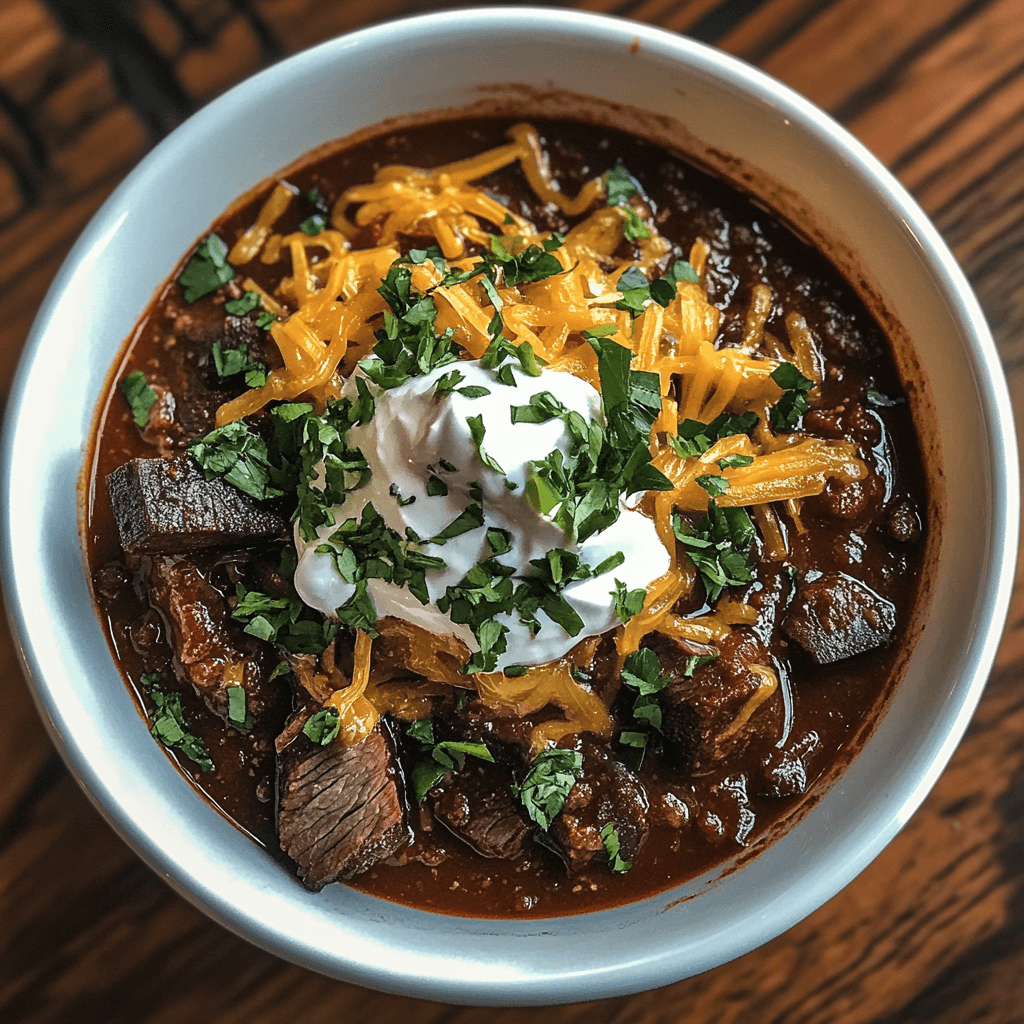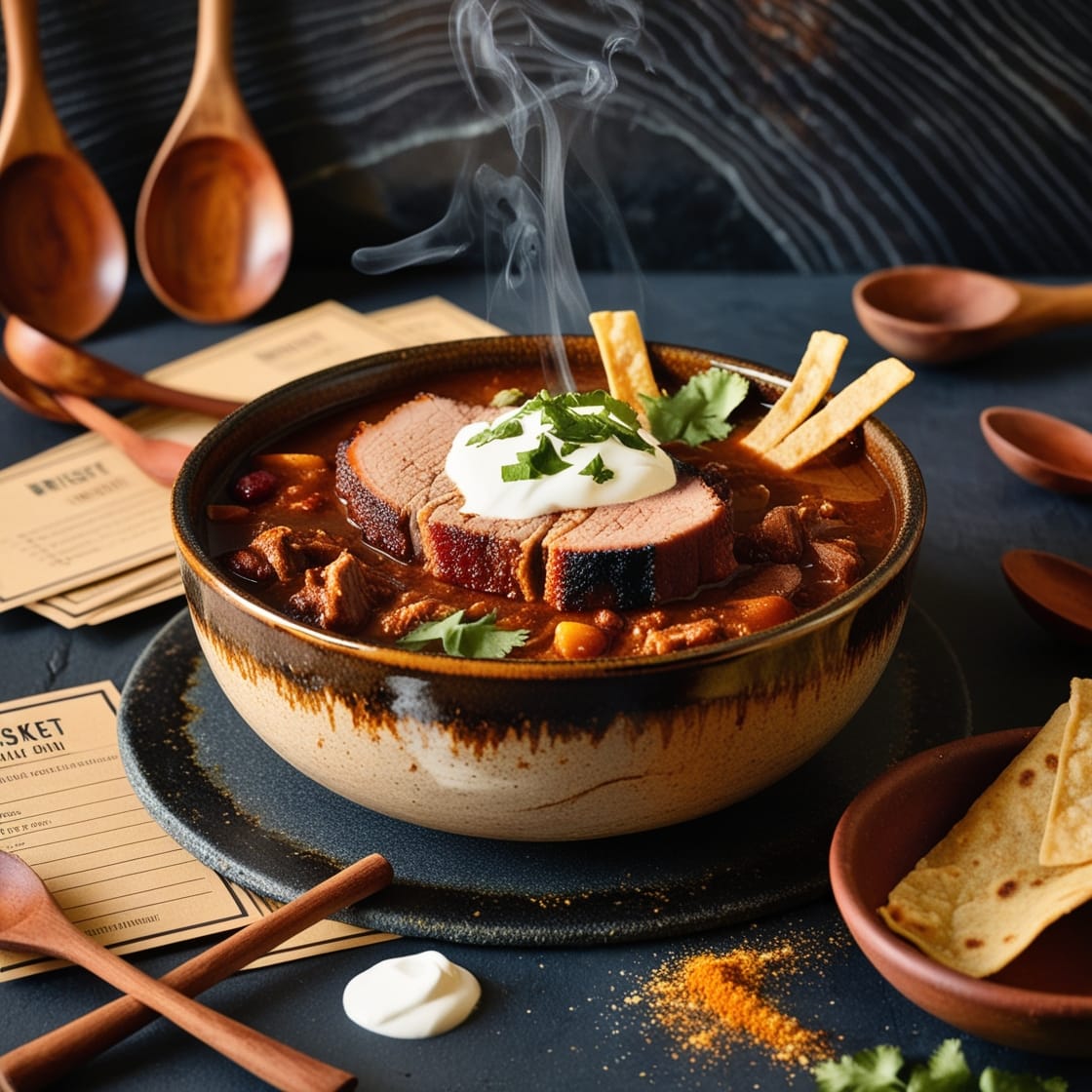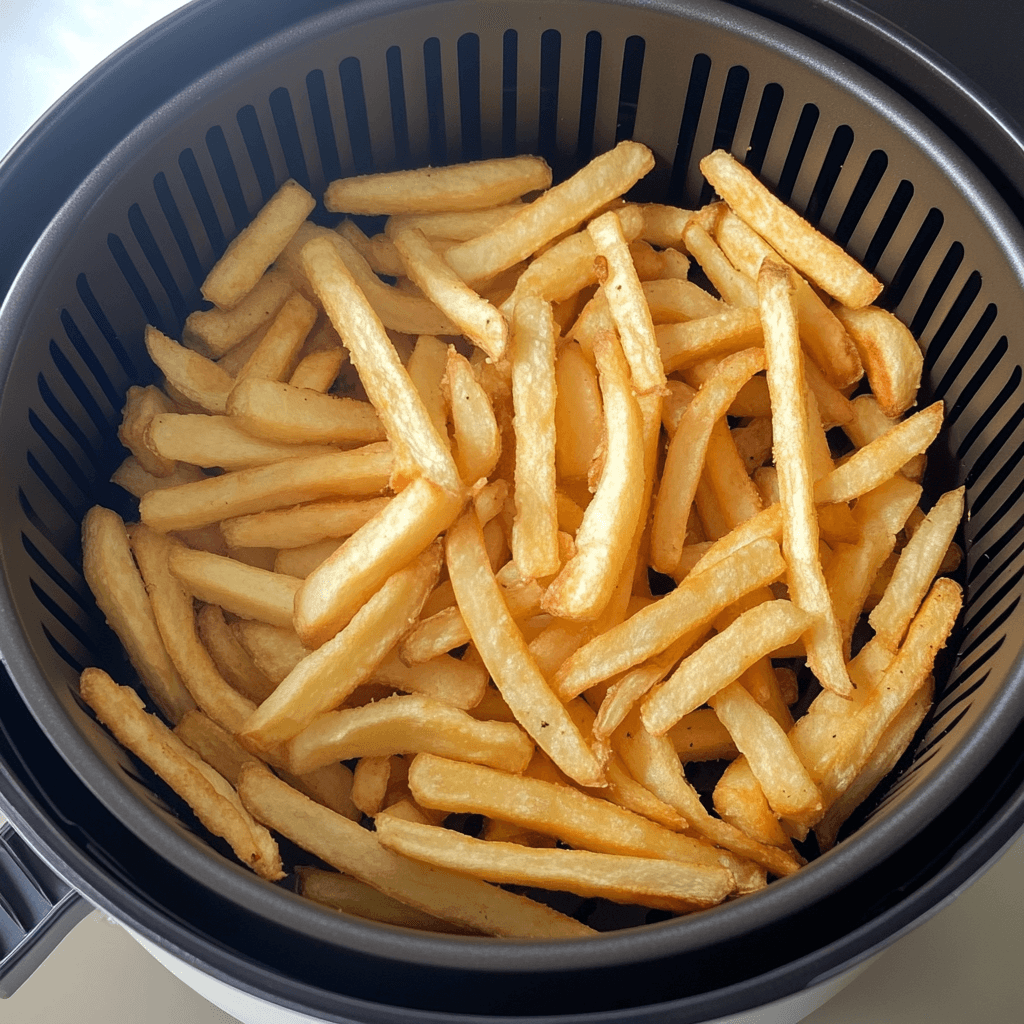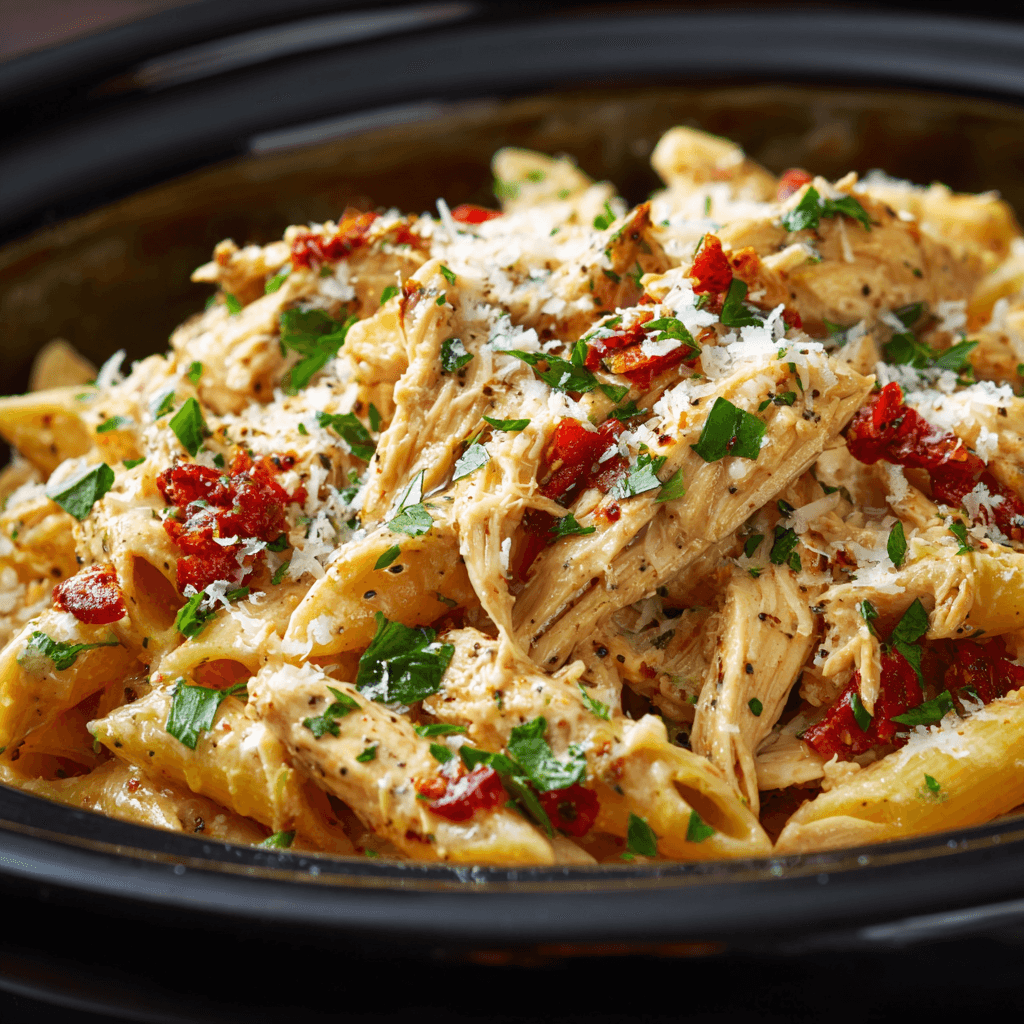Introduction with Keyphrase:
Looking for the ultimate comfort food? This brisket chili recipe is a game-changer, combining tender, slow-cooked brisket with bold spices to create a rich, hearty dish that’s perfect for any occasion. Whether you’re hosting a family dinner or a game-day gathering, this recipe delivers smoky, savory flavors in every bite.
What is Brisket Chili?
Brisket chili is a hearty and flavorful dish that combines tender, slow-cooked brisket with the bold, spicy, and savory ingredients typical of chili. Unlike traditional ground beef chili, brisket chili uses chunks or shredded pieces of smoked or braised beef brisket, adding a rich and smoky flavor to the dish.
The base typically includes tomatoes (in the form of crushed tomatoes, tomato paste, or diced tomatoes), chili peppers, and a mix of spices like chili powder, cumin, paprika, garlic, and onion powder. Beans are sometimes included, though this depends on regional preferences and personal taste.
Brisket chili can be cooked on a stovetop, in a slow cooker, or in an instant pot, allowing the flavors to meld together over time. It’s often served with toppings such as shredded cheese, sour cream, chopped onions, or fresh cilantro, and can be accompanied by cornbread, tortilla chips, or rice.
This dish is popular at cookouts, family gatherings, and competitive chili cook-offs due to its depth of flavor and ability to satisfy hearty appetites.
The Origins of Chili and Its Evolution
Chili, often referred to as chili con carne (meaning “chili with meat” in Spanish), traces its roots to the culinary traditions of the American Southwest and Mexico. While its exact origins are debated, chili is thought to have emerged as a fusion of Spanish, Mexican, and Native American influences. Early recipes included dried chili peppers, meat, and herbs, reflecting the simplicity of frontier cooking.
Over time, chili evolved into a beloved dish across the United States, with regional variations emerging. Texas chili, for example, traditionally excludes beans and focuses on meat and chili peppers, while other regions incorporate beans, tomatoes, and diverse spices. Chili’s adaptability has made it a staple in American cuisine, celebrated at cook-offs and served as comfort food.
Why Brisket Takes Chili to the Next Level
Brisket elevates chili by introducing a depth of flavor and texture that surpasses traditional ground beef. Known for its rich, marbled fat and robust beefy taste, brisket becomes incredibly tender when cooked low and slow, absorbing the spices and seasonings of the chili base. The smoky undertones from smoked or grilled brisket add a complexity that complements the boldness of chili spices.
Additionally, brisket’s fibrous texture provides a satisfying, hearty bite, creating a more luxurious and indulgent chili experience. Its ability to hold up well in prolonged cooking ensures the dish is rich and cohesive, making brisket chili a favorite among barbecue enthusiasts and chili aficionados alike.
Key Ingredients for Brisket Chili
- Brisket: The star ingredient, either smoked, braised, or slow-cooked until tender and flavorful.
- Tomatoes: Crushed tomatoes, diced tomatoes, or tomato paste form the base, adding acidity and sweetness.
- Chili Peppers: Fresh or dried, such as jalapeños, ancho, or chipotle, for heat and smokiness.
- Beans (Optional): Black beans, kidney beans, or pinto beans for added texture and heartiness.
- Onions and Garlic: Aromatics that build the foundational flavors.
- Spices: Chili powder, cumin, paprika, cayenne, and oregano for a bold, layered seasoning.
- Beef Broth or Stock: Adds moisture and enhances the savory taste.
- Sugar or Chocolate (Optional): A touch of sweetness to balance the spice and acidity.
- Toppings: Sour cream, shredded cheese, chopped onions, cilantro, or jalapeños for garnish.
These ingredients, combined with slow cooking, create a deeply flavorful and satisfying brisket chili perfect for any occasion.
Choosing the Right Brisket Cut
Selecting the right cut of brisket is crucial for making delicious brisket chili. Brisket comes in two main parts:
- Flat Cut (First Cut): This leaner cut has a consistent thickness and is easier to slice. It’s ideal if you prefer less fatty chili but still want tender chunks of meat.
- Point Cut (Second Cut): This cut is marbled with more fat, making it juicier and more flavorful when slow-cooked. It’s perfect for those seeking a richer chili with a melt-in-your-mouth texture.
For brisket chili, the point cut is often preferred due to its higher fat content, which renders beautifully during cooking and infuses the chili with a deep, beefy flavor.
Spices and Seasonings for the Perfect Flavor
Spices are the heart of any chili, and brisket chili benefits from a robust and well-balanced seasoning blend. Here are the key spices and their roles:
- Chili Powder: The backbone of the flavor, providing warmth and spice.
- Cumin: Adds earthy, nutty undertones that complement the beef.
- Paprika: Choose smoked paprika for an extra layer of smokiness.
- Cayenne Pepper: For heat, adjust based on your spice tolerance.
- Oregano: Offers herbal notes to balance the intensity of the chili.
- Garlic Powder and Onion Powder: Enhances the savory depth.
- Salt and Pepper: Essential for seasoning the brisket and the overall dish.
Optional spices include cinnamon, cocoa powder, or allspice for a hint of complexity that pairs well with the smokiness of the brisket.
Beans, Tomatoes, and Optional Add-Ins
The supporting ingredients in brisket chili help build its rich texture and flavor profile:
- Beans (Optional): Black beans, kidney beans, or pinto beans add heartiness but can be omitted for a more traditional Texas-style chili.
- Tomatoes: Use crushed tomatoes, tomato paste, or diced tomatoes as the base for acidity and sweetness.
- Stock or Broth: Beef broth enhances the savory richness of the dish.
- Onions and Garlic: Key aromatics that lay the foundation for flavor.
- Sweeteners (Optional): Brown sugar, honey, or even chocolate can balance out the spiciness.
- Vegetables (Optional): Bell peppers, jalapeños, or corn can be added for texture and variety.
Essential Tools for Cooking Brisket Chili
Having the right tools ensures your brisket chili cooks evenly and develops its full flavor potential. Here are some essentials:
- Knife and Cutting Board: For trimming and cubing the brisket.
- Large Spoon or Ladle: For stirring and serving.
- Thermometer (Optional): To monitor the brisket’s internal temperature if pre-smoking or grilling.
Choosing Between a Dutch Oven, Slow Cooker, or Instant Pot
The cooking vessel plays a significant role in determining the texture and convenience of making brisket chili. Here’s a comparison:
- Dutch Oven:
- Pros: Provides even heat distribution and is ideal for slow simmering on the stovetop or in the oven. Great for building flavors with sautéed aromatics.
- Cons: Requires more active monitoring compared to other methods.
- Slow Cooker:
- Pros: Perfect for hands-off cooking. Allows the brisket to cook low and slow, resulting in tender meat and well-blended flavors.
- Cons: Lacks the ability to brown or sear ingredients directly.
- Instant Pot:
- Pros: Significantly reduces cooking time without sacrificing tenderness. Many models allow for sautéing, so you can sear the brisket and deglaze the pot.
- Cons: May require careful adjustment of liquid to avoid overcooking.
Choose based on your available time and preference for hands-on cooking versus convenience. Each method yields a delicious brisket chili when used effectively.
Additional Equipment for Enhanced Flavor
To take your chili to the next level, consider using some additional equipment that enhances the flavors and textures of your brisket chili:
- Cast Iron Skillet or Dutch Oven: These provide even heat distribution and allow you to sear the brisket effectively, locking in flavors before slow cooking.
- Smoker or Grill: For a smoky flavor, pre-smoking or grilling the brisket can add depth to the chili.
- Immersion Blender: For those who prefer a smoother chili, this tool helps blend the ingredients directly in the pot.
- Meat Thermometer: Ensures the brisket is cooked to perfection, tender and juicy.
- Wood Chips or Pellets (if smoking): Enhance the smoky flavor with hickory, mesquite, or applewood chips.
How to Prepare Brisket for Chili
Preparing brisket for chili involves a few essential steps to ensure the meat becomes tender, flavorful, and integrates seamlessly into the dish. Here’s a step-by-step guide:
- Choose the Right Cut: Look for a well-marbled piece of brisket for rich flavor and tender texture.
- Trim Excess Fat: Remove excess fat to avoid a greasy chili, but leave a thin layer for moisture and flavor during cooking.
- Season Generously: Use a spice rub or marinade with salt, pepper, paprika, and garlic powder to infuse the meat with flavor before cooking.
Trimming and Prepping the Brisket
- Trim the Fat Cap: Use a sharp knife to carefully trim the thick fat cap, leaving about ¼ inch of fat for moisture and flavor.
- Remove Silverskin: This tough, shiny layer of connective tissue won’t break down during cooking, so remove it for better texture.
- Cut into Cubes or Keep Whole: Depending on your recipe, you can cut the brisket into bite-sized cubes for a chunkier chili or cook it whole for shredding later.
- Season Thoroughly: After trimming, rub the brisket with your preferred seasoning mix. Let it sit for 30 minutes to an hour to absorb the flavors.
- Optional Pre-Smoking or Searing: For enhanced flavor, smoke the brisket for 1-2 hours or sear it in a hot skillet to create a flavorful crust before adding it to the chili pot.
Proper preparation ensures your brisket chili will have a bold and satisfying flavor profile, making it a hit at any gathering.
Marinating vs. Dry Rubbing the Meat
Choosing between marinating and dry rubbing brisket depends on the flavor profile you want to achieve and the cooking method you’ll use:
- Marinating:
- Pros: Adds moisture and infuses the meat with deep flavors from liquid-based ingredients like citrus juice, vinegar, or Worcestershire sauce.
- Best For: When you want tangy, complex flavors or are using leaner cuts that need extra moisture.
- Process: Combine liquid ingredients with spices and herbs, and let the brisket soak for 4-24 hours in the refrigerator.
- Dry Rubbing:
- Pros: Creates a flavorful crust, enhances the natural taste of the meat, and works well for high-heat searing or smoking.
- Best For: When you want a bold, smoky, or spicy profile.
- Process: Rub a mixture of spices and seasonings onto the brisket’s surface and let it rest for at least 30 minutes or up to overnight for deeper flavor.
Step-by-Step Cooking Process
- Prepare the Brisket:
- Trim excess fat and silverskin, season the meat with either a marinade or dry rub, and let it rest.
- Sear the Meat (optional):
- Heat a skillet or Dutch oven until smoking hot and sear the brisket on all sides for a rich crust and enhanced flavor.
- Build the Chili Base:
- Sauté aromatics like onions, garlic, and bell peppers until softened.
- Add spices, such as chili powder, cumin, and smoked paprika, to toast and enhance their flavors.
- Combine Ingredients:
- Add canned tomatoes, beans (if using), broth, and any additional seasonings to the pot.
- Incorporate the seared or prepared brisket.
- Simmer Low and Slow:
- Cook on low heat for several hours, allowing the flavors to meld and the brisket to become tender.
- Adjust Seasonings:
- Taste and adjust with salt, pepper, or a touch of sugar to balance flavors before serving.
Searing the Brisket for Depth of Flavor
Searing the brisket is a critical step for adding richness to your chili. Here’s how to do it effectively:
- Preheat the Pan:
- Use a heavy-bottomed skillet or Dutch oven, and heat it until very hot. Add a small amount of oil to prevent sticking.
- Sear All Sides:
- Place the brisket in the pan and let it develop a golden-brown crust on each side without moving it too soon. This process takes about 2-3 minutes per side.
- Deglaze the Pan:
- Once the brisket is seared, remove it from the pan and pour in a splash of broth or wine to lift the flavorful bits stuck to the bottom. This deglazing liquid is added back to the chili for extra depth.
Building the Flavorful Chili Base
The chili base is the heart of the dish. Here’s how to make it exceptional:
- Sauté Aromatics:
- Heat oil in the pot and sauté diced onions, garlic, and bell peppers until soft and fragrant.
- Toast the Spices:
- Add chili powder, cumin, smoked paprika, and oregano directly to the hot aromatics. Stir for 1-2 minutes to release their oils and deepen their flavors.
- Incorporate Liquids:
- Add canned diced tomatoes, tomato paste, and broth. Stir to combine.
- Enhance the Flavor:
- Mix in ingredients like a splash of vinegar, a teaspoon of sugar, or dark chocolate for complexity.
- Layer Additional Ingredients:
- Add beans (if desired), chopped green chilies, or roasted peppers for texture and flavor.
- Simmer Slowly:
- Once all ingredients are combined, reduce the heat and simmer gently. This allows the flavors to meld and the base to thicken into a rich, hearty mixture.
By combining these techniques, your brisket chili will be flavorful, well-balanced, and irresistibly satisfying.
Slow Cooking for Maximum Tenderness
Slow cooking is the key to achieving fall-apart tender brisket that melts in your mouth. Here’s how to master the technique:
- Choose the Right Equipment:
- Use a slow cooker, Dutch oven, or an oven-safe pot with a lid for consistent, low-temperature cooking.
- Set the Temperature:
- Cook on low heat (around 200–250°F) for 6-8 hours, or until the brisket is fork-tender. For slow cookers, use the “low” setting.
- Add Enough Liquid:
- Ensure the brisket is partially submerged in a flavorful liquid, such as beef broth, beer, or a tomato-based sauce, to prevent drying out.
- Avoid Overcrowding:
- Leave room for the heat to circulate around the brisket and other ingredients for even cooking.
- Check Occasionally:
- Stir gently every couple of hours to ensure nothing sticks and the flavors meld evenly.
Variations on Brisket Chili
Brisket chili is a versatile dish that can be adapted to suit different tastes and regional preferences. Here are a couple of popular variations:
Texas-Style Brisket Chili (No Beans)
Texas-style chili is all about the meat and bold, smoky flavors, with no beans or unnecessary fillers.
Key Features:
- No beans, tomatoes are optional.
- Emphasizes smoky, meaty flavors with a rich chili paste.
How to Make:
- Prepare the Brisket: Sear chunks of brisket to create a crust and lock in flavor.
- Build a Rich Chili Base:
- Combine dried chilies (like ancho or guajillo), soaked and blended into a paste, with beef broth.
- Sauté onions, garlic, and spices like cumin and chili powder.
- Simmer:
- Add the brisket and chili paste to the pot with a splash of beer or coffee for depth. Cook low and slow until tender.
Smoky Chipotle Brisket Chili
This variation incorporates the smoky heat of chipotle peppers for a bold, spicy chili.
Key Features:
- Uses chipotle peppers in adobo sauce for a smoky kick.
- Often includes roasted tomatoes and a touch of sweetness, like honey or brown sugar, to balance the spice.
How to Make:
- Sear and Smoke:
- Sear the brisket and optionally smoke it for an hour to enhance the flavor.
- Create the Base:
- Sauté onions, garlic, and roasted red peppers in a Dutch oven.
- Stir in chipotle peppers, adobo sauce, and roasted tomatoes for a deep, smoky flavor.
- Combine Ingredients:
- Add brisket, beans (optional), broth, and a hint of honey or chocolate for balance.
- Slow Cook:
- Simmer for several hours until the brisket is tender and the flavors are well-integrated.
Final Touches for Any Variation
- Garnish: Serve with toppings like shredded cheese, sour cream, chopped cilantro, or sliced jalapeños.
- Accompaniments: Pair with cornbread, tortilla chips, or a side of rice for a complete meal.
Each variation showcases brisket in its glory, whether you prefer the purist approach of Texas-style or the smoky allure of chipotle-infused chili.

Vegetarian-Inspired Brisket Chili (Meat Substitute Options)
For those who love the flavors of brisket chili but prefer a vegetarian option, there are excellent meat substitutes that can replicate the hearty texture and rich taste of brisket. Here are a few ideas:
- Jackfruit:
- Texture: Pulled jackfruit mimics shredded brisket when cooked and seasoned properly.
- Preparation: Sauté jackfruit with spices, then simmer in the chili base until tender.
- Seitan (Wheat Gluten):
- Texture: Dense and chewy, it closely resembles the texture of slow-cooked meat.
- Preparation: Cube or shred seitan, sear it for a crust, then add it to the chili base.
- Plant-Based Meat Crumbles:
- Texture: Ground meat substitutes work well for a chunkier, more traditional chili texture.
- Preparation: Brown the crumbles before incorporating them into the chili.
- Portobello Mushrooms:
- Texture: When diced or sliced, portobellos add a meaty texture and earthy flavor.
- Preparation: Sauté or roast mushrooms before adding to the chili.
- Lentils or Chickpeas:
- Texture: These provide a hearty, protein-rich alternative.
- Preparation: Cook them in the chili base until tender, or use canned for convenience.
Serving Brisket Chili Like a Pro
Elevate your brisket chili presentation with these tips to impress your guests:
- Use Individual Bowls:
- Serve in rustic ceramic or stoneware bowls for a cozy, homemade feel.
- Layer Toppings Artfully:
- Arrange toppings in small piles for a colorful, professional look.
- Provide Garnish Options:
- Offer a topping bar with items like sour cream, shredded cheese, green onions, and jalapeños, allowing guests to customize their bowls.
- Accompany with Sides:
- Serve with warm cornbread, tortilla chips, or fresh-baked rolls for a complete meal.
Best Toppings for Chili Perfection
Toppings can enhance the flavors and textures of your chili. Here are some classics and creative options:
- Classics:
- Shredded Cheddar or Monterey Jack cheese
- Sour cream or Greek yogurt
- Diced green onions or fresh cilantro
- Sliced jalapeños or pickled peppers
- Crunchy Additions:
- Crushed tortilla chips
- Crispy fried onions
- Cornbread croutons
- Flavor Enhancers:
- Hot sauce or sriracha for spice
- A squeeze of lime juice for acidity
- Drizzle of honey or agave for sweetness
- Unique Ideas:
- Avocado slices or guacamole
- Toasted pumpkin seeds (pepitas)
- Crumbled queso fresco or feta
Suggested Side Dishes to Complement the Chili
Pair your brisket chili with sides that complement its rich flavors and hearty texture:
- Breads and Carbs:
- Cornbread: Classic, sweet, or jalapeño-infused varieties.
- Tortilla Chips: Perfect for dipping or adding crunch.
- Rice: White, brown, or cilantro-lime rice as a base.
- Fresh Salads:
- Coleslaw: A tangy, creamy slaw cuts through the richness.
- Avocado Salad: A light, citrusy salad balances the heat and bold flavors.
- Corn Salad: Grilled corn with lime and cotija cheese adds a sweet, zesty contrast.
- Vegetable Sides:
- Grilled Vegetables: Zucchini, bell peppers, or asparagus add a smoky touch.
- Roasted Sweet Potatoes: Their sweetness complements the chili’s spice.
- Beverage Pairings:
- A cold beer, tangy margarita, or iced tea enhances the dining experience.
With these tips and options, your brisket chili will not only taste amazing but also look and feel like a gourmet experience.
Storing and Reheating Leftovers
Brisket chili often tastes even better the next day as the flavors meld further. Proper storage and reheating ensure it stays fresh and delicious.
Proper Storage Techniques
- Cool Completely:
- Allow the chili to cool to room temperature before storing to prevent condensation and spoilage.
- Use Airtight Containers:
- Transfer the chili into airtight containers or resealable bags to maintain freshness and prevent odor transfer.
- Portion for Convenience:
- Store in individual serving sizes to make reheating quicker and more efficient.
- Label and Date:
- Mark containers with the storage date to track freshness. Brisket chili can last:
- In the Refrigerator: Up to 4 days.
- In the Freezer: Up to 3 months.
- Freeze Properly:
- Lay freezer bags flat for efficient storage and faster thawing. For containers, leave some space for expansion during freezing.
Reheating Without Losing Flavor
- Thaw First (If Frozen):
- Move the chili from the freezer to the refrigerator the night before reheating. For quick thawing, place the container in a bowl of cold water.
- Use Low Heat:
- Reheat on the stovetop over low to medium heat, stirring occasionally to ensure even heating and prevent sticking.
- Add Moisture If Needed:
- If the chili has thickened too much, add a splash of broth or water to restore the desired consistency.
- Microwave in Intervals:
- For faster reheating, use the microwave in 1-2 minute intervals, stirring between each to distribute heat evenly.
- Taste and Adjust:
- Reheated chili may need a flavor boost; consider adding a pinch of salt, fresh spices, or a squeeze of lime juice.
Common Mistakes and How to Avoid Them
Making brisket chili can be straightforward, but avoiding these common mistakes ensures a better outcome:
- Mistake: Skipping the Sear:
- Why It Matters: Searing caramelizes the meat’s surface, enhancing flavor and creating a rich base for the chili.
- Fix: Always take time to brown the brisket before slow cooking.
- Mistake: Overcrowding the Pot:
- Why It Matters: Overcrowding prevents even cooking and browning.
- Fix: Cook in batches if necessary to allow proper heat circulation.
- Mistake: Not Cooking Long Enough:
- Why It Matters: Brisket needs slow cooking to become tender and flavorful.
- Fix: Plan for at least 6-8 hours of slow cooking, either in a slow cooker or on low heat.
- Mistake: Under-Seasoning:
- Why It Matters: Chili relies on bold, layered flavors.
- Fix: Taste as you cook and adjust seasonings throughout the process.
- Mistake: Adding Beans Too Early:
- Why It Matters: Beans can become mushy if cooked too long.
- Fix: Add canned beans during the last hour of cooking.
- Mistake: Ignoring Consistency:
- Why It Matters: Chili that’s too watery or too thick affects the eating experience.
- Fix: Simmer uncovered to thicken or add broth if it becomes too thick.
By following these tips, your brisket chili will store, reheat, and serve as a delicious meal time and again while avoiding common pitfalls.
Overcooking or Undercooking the Brisket
Cooking brisket for chili requires precision to ensure it is tender and flavorful. Here’s how to avoid common pitfalls:
Overcooking the Brisket
- What Happens: Overcooked brisket can become mushy and lose its structure, falling apart excessively in the chili.
- How to Avoid It:
- Monitor Cooking Time: Use a timer and avoid cooking brisket for longer than 8-10 hours on low heat in a slow cooker.
- Check for Doneness: Test with a fork. Properly cooked brisket should be tender but still hold its shape.
- Cook in Larger Pieces: Instead of cutting the brisket into small chunks initially, cook it in larger sections to reduce the risk of overcooking. Shred or cube it toward the end of cooking.
Undercooking the Brisket
- What Happens: Undercooked brisket is tough, chewy, and doesn’t integrate well with the chili.
- How to Avoid It:
- Cook Low and Slow: Brisket requires long, slow cooking to break down the connective tissues and render the fat.
- Check Internal Temperature: For whole brisket pieces, aim for an internal temperature of 195–205°F, where the meat is tender and juicy.
- Patience is Key: Avoid rushing the process by using high heat, which can lead to uneven cooking.
Balancing Heat and Sweetness in the Chili
Achieving the perfect balance between heat and sweetness is crucial for a flavorful chili. Here’s how to master it:
Managing Heat Levels
- Control the Spices:
- Start with moderate amounts of chili powder, cayenne, or chipotle peppers. You can always add more later.
- Mild Alternatives:
- Use sweet bell peppers or smoked paprika for flavor without adding heat.
- Neutralize Excess Heat:
- If the chili becomes too spicy, add dairy (sour cream or Greek yogurt), a touch of sugar, or extra broth to tone it down.
Enhancing Sweetness
- Add Sweet Ingredients:
- A small amount of brown sugar, honey, molasses, or maple syrup can complement the spices without overpowering the dish.
- Balance with Acidity:
- Add a splash of vinegar, lime juice, or tomato paste to balance sweetness and bring out the flavors.
Achieving the Right Balance
- Taste and Adjust:
- Continuously taste the chili during cooking to ensure the flavors are balanced. A little sweetness should round out the heat but not dominate.
- Layer Flavors:
- Build complexity by combining heat sources (e.g., chili powder and fresh chilies) and sweetness (e.g., roasted vegetables and brown sugar) in small, incremental amounts.
With these techniques, your chili will have a harmonious blend of heat and sweetness, pleasing every palate.
FAQs About Brisket Chili Recipe
What is the 3-2-1 Rule for Brisket?
The 3-2-1 rule is a guideline commonly used in smoking brisket to ensure tenderness and a flavorful crust:
- 3 Hours Unwrapped: Smoke the brisket directly on the grill for 3 hours at a low temperature (around 225°F) to develop a flavorful bark.
- 2 Hours Wrapped: Wrap the brisket tightly in foil or butcher paper and return it to the smoker for 2 hours. This step retains moisture and allows the meat to tenderize.
- 1 Hour Resting: Let the brisket rest, still wrapped, for at least 1 hour after removing it from the smoker. This helps redistribute juices and enhances the texture.
While this method is ideal for smoked brisket, brisket for chili typically skips the long rest since it will be further simmered in the chili base.
What Part of Brisket Is Best for Chili?
- Point Cut: The point end of the brisket is best for chili because it has more marbling and fat content, resulting in tender, flavorful meat when slow-cooked.
- Flat Cut: The flat cut is leaner but can still work well in chili if cooked with care to prevent it from drying out. It’s a good choice if you prefer less fat in your dish.
What Is the Best Meat for Chili?
Brisket is a standout choice for chili, but other meats can also be used depending on your preference:
- Brisket: Ideal for hearty, flavorful chili with a tender, shredded texture.
- Ground Beef: Classic and widely used, especially in quick recipes.
- Chuck Roast: A budget-friendly cut that’s well-marbled and tender when slow-cooked.
- Short Ribs: Adds richness and depth, especially in bone-in variations.
- Pork Shoulder: For a unique twist, pork provides a slightly sweeter flavor profile.
What Not to Do with Brisket?
Avoid these common mistakes to ensure the best results when cooking brisket for chili:
- Don’t Skip the Sear:
- Searing develops a flavorful crust that enhances the depth of the chili.
- Don’t Use High Heat:
- Brisket needs low and slow cooking to break down connective tissue. High heat leads to tough, chewy meat.
- Don’t Forget to Trim Excess Fat:
- While some fat is necessary for flavor, too much can result in a greasy chili. Remove the thick fat cap but leave a thin layer for moisture.
- Don’t Underseason:
- Brisket requires bold seasonings to stand out in a chili base. Be generous with spices and adjust as needed.
- Don’t Overcrowd the Pot:
- Overcrowding prevents even cooking and can dilute flavors.
By following these tips and insights, your brisket chili will be a flavorful, perfectly cooked masterpiece.
To enhance the visibility and depth of the “brisket chili recipe” article, consider integrating internal links to related content on your site. For instance, readers interested in flavorful and hearty meals may appreciate exploring The Ultimate Guide to Smoked Meatloaf Recipe, which offers insights into preparing another smoked dish with rich, savory flavors. Additionally, linking to lighter baked goods like Pumpkin Banana Loaf can provide a complementary dessert pairing for your chili meal. These strategic links enhance user navigation while boosting SEO through relevant anchor text connections.
What’s the best way to store leftovers?
Keep leftovers in an airtight container in the fridge for up to 4 days. Reheat in the microwave or oven until hot and bubbly. For food safety tips, refer to USDA guidelines on leftovers .
Conclusion: Why Brisket Chili Should Be Your Next Go-To Dish
Brisket chili is more than just a meal—it’s an experience. The tender, slow-cooked brisket, infused with bold spices and rich, smoky flavors, transforms a simple chili into a dish that stands out at any table. Whether you’re serving it for a cozy family dinner, a weekend gathering, or a festive occasion, this recipe is sure to impress. Its versatility, depth of flavor, and hearty satisfaction make it a timeless go-to dish. Once you’ve tried this brisket chili recipe, it’s bound to become a staple in your kitchen, celebrated for its comfort and culinary excellence.






12 thoughts on “The Ultimate Brisket Chili Recipe: A Smoky, Savory Delight”
Comments are closed.